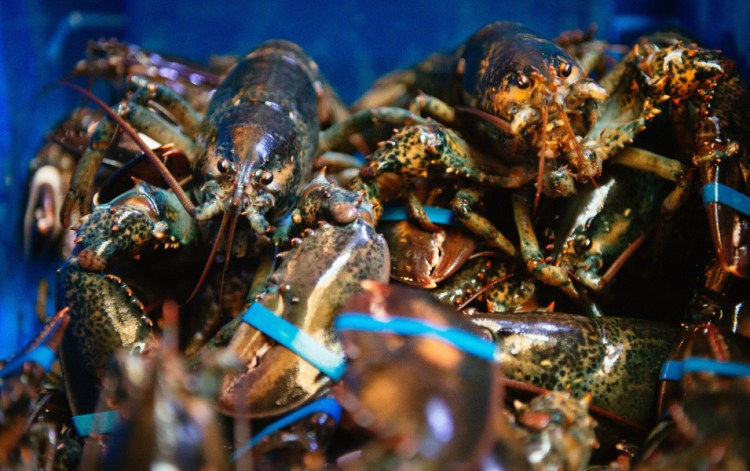Swedish scientists readily admit they don’t have the science to prove that American lobsters have invaded North Atlantic waters and become established there, but say the threat to their small native lobster population is real and can only be fully neutralized by an import ban.
Their findings, released in advance of an Aug. 31 ruling by a European Union committee on whether U.S. lobsters are an invasive species, argue that American lobsters have mated with native species. The scientists support banning imports of the lobsters as a precaution.
“There is a major difference between assessing the likelihood that establishment will occur and assessing the risk,” the Swedish Agency for Marine and Water Management said in a report. “Documented establishment in Europe is exactly what we want to avoid. The biggest difference between the North American reviews and the Swedish is how the precautionary principle is handled. … Prevention is generally more desirable than reaction after the fact.”
At stake are more than $136 million in live lobster exports from Maine and Massachusetts to the EU (most Maine lobster is exported through Boston).
Within the report is information that worries scientists: In 2009, a wild American lobster that was caught in Norwegian waters had mated with a European lobster. It successfully gave birth, and its offspring, a hybrid of the two species, are still being held in a lab there for study.
But the Norwegian government doesn’t have the money to test if these 7-year-old hybrids are sexually mature or if they can spawn fertile offspring of their own. That means it’s impossible to know if American-European hybrids have the biology needed to one day, given the right circumstances, take over the waters of the North Atlantic and edge out their smaller-clawed European cousins.
Scientists from Sweden, which is leading the campaign to ban the import of live American lobsters to the 28 countries that make up the EU, say it doesn’t matter. While such knowledge would be nice, Sweden argues that the EU shouldn’t wait for proof that an invasion is actually underway before it takes action. The best time to stop an invasive species from taking over a new habitat is before it happens, not after, when eradication efforts are often expensive and rarely successful in turning an invader away, especially one as elusive as an underwater crustacean, the scientists argued in their July report.
The study that has taken place in Norway found that American lobsters with hybrid eggs successfully hatched their eggs, producing the same size and number of eggs as a wild-caught American lobster found carrying pure eggs. This suggests the egg-laying process and survival of eggs in North Atlantic waters seem not to be affected by temperature differences from North American lobsters, the Swedish scientists told the EU environment committee, the panel that will rule next week on the invasive species issue.
Some American and Canadian scientists had speculated that the warmer waters of the North Atlantic during winter might prevent sexual maturation, but the Swedish scientists believe that the American females were able to crawl to deeper, colder waters. If such migration wasn’t possible, Swedish scientists noted that European lobsters that couldn’t make it to colder waters had still been able to produce embryos and larvae, but of smaller size and quality. Warmer waters were not optimal, but they weren’t lethal for the entire clutch, they noted.
But the U.S. government continues to stand by its earlier claim that the Swedish environmental assessment is rife with extrapolation, conjecture and anecdotes, and lacking the science needed to list a species as invasive under European Union regulations.
This is especially troubling given the socioeconomic impacts that a ban on live American lobster imports would have on American fishermen as well as EU importers, retailers and consumers, said Eileen Sobeck, the National Oceanic and Atmospheric Administration’s assistant administrator for fisheries.
Such a ban would remove from European markets almost 28 million pounds of U.S. and Canadian lobster valued at more than $200 million annually, Sobeck said in an Aug. 16 letter. That ban would present a “significant and unjustified barrier to trade,” Sobeck said.
On Tuesday, Maine’s congressional delegation issued a joint statement saying the U.S. could file an objection with the World Trade Organization if the EU decides to impose the ban “in the absence of strong scientific evidence.”
Sweden first submitted its petition to list the American lobster as invasive in March, citing discovery of two dozen American lobsters off the coast of Great Britain, Norway and Sweden in the past 30 years. Sweden said a ban would protect the native European lobster from crossbreeding and diseases, and its habitat and food from its more rapacious American cousin.
The U.S. and Canadian governments replied in June, saying the science behind the proposal was weak. Political leaders from both countries, including Maine’s delegation, accused Sweden of trying to protect the Swedish economy instead of a species.
The EU must wait for the decision of its environment committee before it can rule on a ban.
Send questions/comments to the editors.



Success. Please wait for the page to reload. If the page does not reload within 5 seconds, please refresh the page.
Enter your email and password to access comments.
Hi, to comment on stories you must . This profile is in addition to your subscription and website login.
Already have a commenting profile? .
Invalid username/password.
Please check your email to confirm and complete your registration.
Only subscribers are eligible to post comments. Please subscribe or login first for digital access. Here’s why.
Use the form below to reset your password. When you've submitted your account email, we will send an email with a reset code.